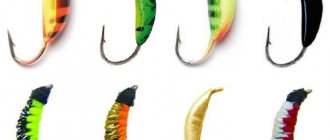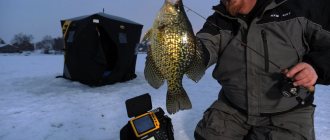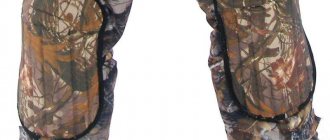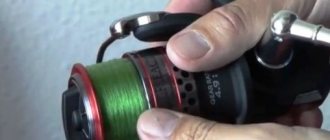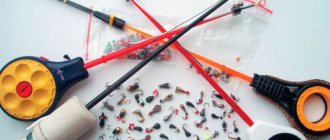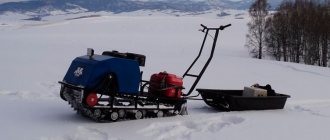Winter fishing involves penetrating the gear under the ice. And for this you need to use an ice drill. When choosing a drill, its maintenance and use, a number of subtleties and nuances must be taken into account. So, in this article I will talk about a number of points that novice winter fishermen may not know. How to drill holes correctly, how to use the drill effectively and so that it serves you long and reliably.
We will talk about the types and models of drills, somehow, in future articles. Regardless of the manufacturer of the drill, the main condition for easy and fast drilling, of course, is the sharpness and correct sharpening of the ice drill knives. Sharp knives with the correct cutting edge geometry easily cut into the ice and the hole is passed quickly and with minimal effort. If the knives are dull, or the edges are drawn incorrectly, then the drill licks the ice and does not really cut into it. And it is possible to drill through only with the application of enormous efforts.
If the drill is in order, drilling technique is of considerable importance. It is important to place the drill vertically. This first movement of the drill towards the ice should not be sudden. It is necessary to smoothly place the drill on the surface of the ice, and not hit it with knives... You need to press the working part tightly to the surface of the ice and drill in with several quick turns. At the same time, large angles of deviation of the drill from the vertical axis should be avoided. Beating is inevitable. But, if you reduce it to a minimum, it will be possible to drill the entire hole easier and faster, with minimal risk of damaging or quickly dulling the ice drill knives.
When the ice is broken, it is important to carefully drill the hole so that a smooth exit is formed at the bottom, without sharp edges that could damage the line of the tackle. This is done by sharply (but without fanaticism) jerking the drill upward, towards itself, after the working part has completely passed the ice.
It is important what happens to our drill next, after making the required number of holes. Many people simply place the drill next to them on the ice. This is absolutely not true, and even dangerous! Firstly, you can inadvertently step on the drill yourself and get hurt on the sharp knives. A passing fisherman may step on the drill, or a car or snowmobile may run over it.
The only sure way is to drill an ice drill into the ice so that it stands vertically and is clearly fixed. It is not convenient to hide the tool in the car, because often we change points and drill new holes during fishing.
Secondly, if the drill lies on the snow, it may become covered with ice, which will make it difficult to drill new holes. And attempts to break off the ice will lead to damage to the coating, paint and subsequent rusting. So, don’t make such simple mistakes and take care of your ice auger.
In addition to the above, you can give the following advice.
If you are moving on ice, you should definitely wear protection on your drill. If you slip, you won't run the risk of running into the knives... Also, this precaution will prevent you from injuring your fishing partners.
If the drill nevertheless gets caught in ice, then you cannot knock it off mechanically, with blows. If this happens, you need to lower the working part of the drill into the hole and wait 10-20 minutes for the ice to thaw.
If you are a supporter of actively searching for fish during winter fishing, often moving around and drilling new holes, then you have no time to wait and you need to initially prevent freezing on the auger auger. To prevent this from happening at all, you need to have some kind of rag or old towel with you to remove excess water after completing each series of holes. But, of course, do not try to rub the working part - remember that the knives are sharp! Just dry the auger.
Remember that you cannot drill in the place of old holes. The density of the newly frozen ice is much greater than the ice surrounding the old hole. As a result, when drill knives hit this boundary with different densities, they may simply break, chip, or quickly become dull.
If some unfamiliar fisherman comes up to you and asks for your drill, then there are only two reasonable choices: either send him, or go and drill a couple of holes for him yourself... This way your drill will definitely be more intact. Because a fisherman without his own drill may not be able to use it properly and will ruin it for you right away...
Difficulties often arise when unscrewing the screws that hold the ice auger knives. This occurs due to metal oxidation, rust. You can simplify this process by wrapping several turns of fum tape, used when installing plumbing fittings, onto the screw threads before screwing them in.
If you have a domestically produced ice drill with straight cutting edges, you should know that its drilling efficiency varies greatly with temperature. Thus, standard cutting edge angles work optimally at temperatures down to –5–7 degrees. If the frost is stronger, then the ice, accordingly, becomes harder. To speed up the drilling process, you can place pads on the screws that secure the ice drill knives (the pair of screws that are closer to the drill axis). Sheet metal pads 0.1-0.2mm thick change the angle of attack. This makes ice easier to drill, but keep in mind that the load also increases, and, therefore, the wear of the knives accelerates. So, not everyone goes for these experiments.
These are the tips you should keep in mind when using an ice drill. Use them too!
nik-fish.com
It's no secret that winter fishing is radically different from this exciting pastime in spring, summer and autumn. In particular, this is not only other gear and equipment, but also such an integral and important attribute as an ice screw, without which winter fishing is almost impossible.
Fortunately, today there is a wide selection of these devices, and ice auger manufacturers are not asleep, inventing more and more new models that make it easier to choose for specific conditions. For example, Mora ice drills have various modifications, among which you can find models for the elderly and children (due to the small angle of attack of the cutting part, less force is spent on drilling a hole). The compact model of the Mora ice drill will appeal to anglers who prefer fishing on the first (not thick) ice - that’s right, why carry around extra kilos of iron that won’t be useful at the moment! The variety of ice screws from this long-established Swedish company is amazing - there are models for dry or wet ice, universal, telescopic (for residents of the Far Eastern Federal District and those who like to fish in hummocks) and even those from which you can remove the handle and use it with an electric one. or a gasoline engine.
Each of these products has its own pros and cons, which determines the liking of fishermen for certain models. Traditional hand-held ice augers are compact in size and light in weight, easy to transport and quickly ready for use. At the same time, the process of drilling holes is quite tedious. If we take into account the need to periodically change the fishing location in search of migrating prey, then it takes a lot of time and effort. However, if the fishing method does not involve the use of a large number of holes (for example, fishing for roach or bream), then this is just your option.
Unlike hand-held ice augers, a motorized ice auger is larger in size and has more weight, however, the process of preparing a fisherman’s “workplace” is much shorter and the effort spent on this is significantly reduced. So if you plan to get to your intended fishing spot by snowmobile or motorized towing vehicle, the announced disadvantages of this device will not confuse you at all. The auger itself easily bites into the ice under its own weight, all that remains is to hold the motor drill vertically. Today, the range of products is presented quite widely and differs in technical and operational characteristics. For example, the four-stroke Honda35CC will delight you with its light weight, quiet operation and low fuel consumption. And the Mora ICE H-140 (2.0hp) motorized ice drill is primarily due to its price, despite the wide popularity of this brand.
Electric ice augers have gained the greatest popularity in recent years. In the offered range of such products you can see a design with or without a built-in battery (in this case, to operate an electric ice auger, a snowmobile battery is used, or a separate high-capacity battery that is transported in a sled) . These ice screws are virtually silent and lighter in weight. In terms of productivity and hole drilling time, they are in no way inferior to gasoline units. Electric ice drill JIFFY LECTRIC™ MODEL 53 is the key to reliable and uninterrupted operation for a long time. The warranty period of these American electric ice drills is 2 years, which confirms their unsurpassed quality.
One can only be happy for modern fishermen, who are not burdened with a lack of choice in modern times. Many will say: “Before, we somehow got by with an ice pick!” But that was before - in those days the fish bit more confidently: I dug a hole with an ice pick, filled the box with the catch and went home. Now, sometimes, during the daylight hours, you have to drill more than a dozen holes in search of your luck! Try and run the same way with an ice pick! When going fishing with a brand new acquisition, do not forget about the main thing: we are going, first of all, for the pleasure of the process, and not for the fish! Therefore, it’s still not worth filling the refrigerator to the top.
Happy fishing!
snastimarket.ru
Characteristics
Climbers were the first to use a similar tool called an ice axe. They used to drill holes in the ice to securely attach climbing equipment. It began to be used for drilling ice in reservoirs in the 30-40s of the last century. At first it was called a brace, based on the principle of its operation.
Winter fishing is practiced in those countries where water bodies freeze in winter and getting fish out of the water is not so easy. Therefore, old models are constantly being refined and new ones are being produced, only in countries such as Finland, Sweden and Russia. It is the models of ice drills from these countries that are presented on the domestic market. Models differ in quality and cost.
Material
A good model of ice drill costs a lot of money. Therefore, many winter fishing enthusiasts try to purchase a tool that will serve for many years. Ice screws are made either from ordinary metal or titanium.
As far as we know, titanium is a fairly lightweight material, but much more expensive than ordinary metal. An ice drill made of titanium is convenient because it is lighter, which means less effort and energy will be spent on its use. At the same time, you need to be prepared for the fact that you will have to pay 5-6 thousand rubles for it. Unfortunately, not everyone can purchase such a tool.
Knives
The most important part in an ice drill is the knives. The higher quality the steel from which the knives are made, the more reliable and sharp the knives. The ice drill consists of an auger with knives installed at the end. The diameter of the screw can be different, depending on the design features of the device. Depending on the diameter of the auger, a hole of the appropriate size is drilled.
Ice drills can be used to drill holes with a diameter of 90 to 200 mm, depending on the size of the fish that live in a given reservoir. The optimal diameter of the hole is 100-120mm. In reservoirs where large fish are found, it is advisable to drill holes with a diameter of 200 mm.
Pen
There are several handle designs that require one or two hands. Older models are designed to use one hand, while newer models use two hands. Naturally, drilling a hole with two hands is much easier and faster. Despite this, it takes a little learning to work synchronously with both hands.
Such ice screws easily cope with meter-long ice. For thicker ice, special extensions are provided.
What is used to drill ice?
There are two devices for cutting a hole: an ice pick and an ice drill. The first is a scrap metal, most often with a wooden handle. The crowbar is usually tetrahedral, iron, about half a meter long. Can weigh from 2 to 4.5 kilograms. Its end is pointed. Using an ice pick, you can cut a hole of any size and shape.
The described device was used by fishermen in the old days. Today it has been replaced by a more convenient and effective ice auger. With its help you can break through ice 1–5 meters thick. The hole always turns out to be a neat cylindrical shape.
The tool consists of a rotator, auger and knives. Because of the knives, the process of breaking ice with an ice drill is simpler than with an ice pick. But the hole always has a fixed diameter, and if you come across a fish that is larger than the size of the hole, you have to resort to using an ice pick to widen the hole and pull out the catch.
Knives are the main element of the tool. You need to pay attention to them first. They differ in the shape of the cutting edge: there are straight, hemispherical, two- and three-stage, and serrated. The choice of a specific shape depends on what type of ice will have to be cut, under what conditions this will happen and how often. Ice can be wet, dry (usually if frost is severe), layered and viscous. If you do not know what kind of ice coating you will have to deal with, then you can choose hemispherical knives.
They are considered universal: they cut into thick ice well, do not require much effort, and provide good drilling speed. With the arrival of spring, when the ice becomes wet and layered, such knives are superior to straight knives, which are also considered universal. But when working with them you need to put in more effort, but you can sharpen them yourself.
In severe frosts, it is better to use stepped knives with two cutting edges. They are located at some distance from each other and do not cut, but crumble the ice surface. But you will have to put in a lot of effort to cut a hole with them. Serrated blades are good for sticky, wet, wet ice or ice that contains a lot of sand.
Auger length and welding
The screw consists of a hollow tube, which is its axis, and an Archimedes screw. The latter’s task is to remove ice chips from the hole. Its diameter determines the size of the desired hole. The length of the auger is directly proportional to the thickness of the ice. Some manufacturers provide additional sections with which you can lengthen it if you make a mistake with the size.
An alternative option is an ice drill with a telescopic handle, which allows you to adjust the size of the drill while maintaining the same length of the auger.
The screw can be seamless or welded. Most domestically produced products are produced welded (small compartments are connected by welding). This parameter does not affect the operation of the drill itself, except that less ice forms on a solid one.
If we talk about attaching the Archimedes screw to the axis, then only Rapala products have a weld along the entire length. All others have small connecting areas, and cheap products are generally spot welded. The nature of the seam affects the strength of the structure as a whole. In addition, if during spot welding there is a gap between the components of the auger, then during drilling it will make a lot of noise and also vibrate.
What is the diameter of the ice auger
This parameter depends on what kind of fish you plan to catch. A ten-centimeter ice screw is suitable for small fish (roach, perch up to 0.7 kg and pike up to 1 kg). If the fish is larger, then there is a chance that it will not fit through such an ice hole. In addition, shallow holes freeze faster. Most anglers consider a diameter of 11–15 cm to be universal.
Through such a hole you can pull out almost any fish caught with a jig or a balancer. If you plan to also use girders for fishing, then you need a diameter of 13–15 cm. Through such a hole you can pull out a pike weighing 6–7 kg, pike perch or medium-sized bream. Those who want to catch giants (bream 1–2 kg, pike larger than 7–8 kg) should arm themselves with a minimum diameter of 15 cm. Ideally, it should be 17.5–20 cm in size. Drilling such a hole is extremely difficult.
Material
The majority of ice drills on the market are made of steel. But sometimes you can find titanium products. Their main advantage is their low weight. This is very important, especially when you plan to walk for a long time to the desired place. However, this advantage is also a major disadvantage. The tool does not have enough of its own mass to effectively “bite” into the ice, which is why additional force must be applied. In addition, titanium drills are not coated with paint and varnish, and their surface remains slightly rough, which contributes to the rapid freezing of ice.
Connecting parts
The place where the parts of ice augers connect is usually called a connecting point. It can be folding, removable and telescopic. The latter option is considered optimal, since the length can be adjusted over a wide range. But it happens that in severe frosts this design fails, so many experienced fishermen prefer to choose a drill with a folding connecting unit, because the simpler the mechanism, the more reliable it is. At the same time, it is very important to pay attention to the quality of steel in this place.
Drive type
There are manual drills and with an additional drive. The fisherman's muscular strength is responsible for the quality of the hand's work. These products are quite cheap and create minimal noise during operation. In addition, they do not weigh much and do not require additional elements for operation. But if you come across thick ice, you will have to spend a lot of time and effort to break through its thickness to the water. For this reason, such a tool is used to drill through ice no more than 0.5 m thick.
Ice screws "Nero"
In the city of Rostov, Yaroslavl region, they have mastered the production of a new ice drill “Nero”, which is very popular among fishermen.
In terms of its characteristics, this ice screw is not inferior to the best Swedish models.
Due to the appearance of an impact-resistant wing nut, the model has become more durable. This ice auger can be used to install any commercially available knives. The product set includes spherical knives, as well as covers for the auger and knives.
The price is not high, which makes it accessible to a wide range of anglers.
Swedish ice screws
"Nora" are reliable and high-quality ice screws. Russian engineers have created a similar model. Available with a screw with a diameter from 110 to 200 millimeters. The device allows you to adjust the height of the handle. The blades are made in such a way that the ice ax can drill through wet ice without any problems.
Unfortunately, it takes some getting used to as it rotates in the opposite direction. This is a reliable fishing tool with high-quality welding and high-quality paintwork. In this regard, it is easily cleared of snow. If knives fail, they are difficult to replace or sharpen yourself. Due to the fact that the knives are made of very high quality steel, they quickly become dull when they come into contact with sand, which is abundant in reservoirs.
Types of ice drills and their prices
According to the type of drive, the ice auger is:
• Manual – rotated by hand.
There are one-handed versions, where one of the handles is located on the same axis with the auger, and two-handed ones - with handles spaced on opposite sides of the axis.
The cost starts at 1500 rubles.
• Gasoline – driven by an internal combustion engine.
Among the advantages are the ability to drill large-diameter holes and operability at low temperatures.
The disadvantages of a motorized ice drill include noise, the presence of exhaust gases, and the need for fuel.
The motor of this fishing tool has handles attached on both sides, which act as a frame, and the auger is attached to the gearbox shaft.
Motorcycle ice drills
Technology does not stand still, but is constantly being modernized and developed. Motorized ice augers are replacing hand-held ice augers. And this is not surprising, since man does everything to mechanize manual labor. Every year they become more powerful and, at the same time, lighter, and also more convenient to use.
Gasoline ice screws
Such ice drills operate on a mixture of gasoline and oil in a ratio of 4:0.1. Their knife sizes completely coincide with the knife sizes of hand-held ice augers. In case of breakdown, the entire auger can be replaced.
Since most ice fishing enthusiasts have vehicles, it is not a problem to take a gasoline ice auger with them.
Unfortunately, not every fisherman will be able to purchase it, since he will have to pay 18-20 thousand rubles for the motor alone. For an auger - 5-8 thousand rubles, and also for spare knives from 12 to 15 thousand rubles.
Models of motorized ice drills
If the main characteristics of hand-held ice augers are known, the same cannot be said about motorized ice augers, since there are only one or two models. Therefore, it is difficult to compare which model is more preferable.
Japanese motorized ice drill can work not only on ice. They can drill holes in the ground. Therefore, we can safely say that this is a universal and powerful tool that is not intended for amateur fishing.
The American ice auger is very popular among fishermen because it fully copes with its task.
Electric ice screws
How can we live without power tools, especially in our time? Since the ice drill for winter fishing runs on batteries, it is, most importantly, an environmentally friendly tool. By the way, it is much more pleasant to work with a power tool, since it has no vibration and no extra weight. In addition, it works absolutely silently.
The main condition for reliable operation of an electric ice auger is battery care. Before starting work, it must be discharged and then charged. It charges within one hour. The power tool works without problems in the cold and the battery charge can last for a whole day.
The batteries can be charged both from the network and from the car, which is quite convenient. This device weighs about 9 kg.
fishingday.org
Tips from experienced winter fishermen
First of all, you need to think everything over and make sure that the ice on the reservoir is already strong enough and you can safely step on it without the risk of ending up in icy water. If a newly minted winter angler knows at least a little about a body of water and what fish live in it, then it will be much easier to decide on a fishing spot.
If you need to drill holes in shallow water, then you need to do this at a distance of more than 2 meters so that they are not exposed to light.
In winter, fish are quite shy, so you need to be as careful as possible. Be sure to remove away all the ice crumbs that formed after drilling the holes. After all, creaking underfoot, they (ice chips) can scare away prey. For example, fish such as bream are generally extremely shy, and such crunches will only ruin the whole fishing trip.
In addition, ice chips near the holes will periodically interfere with the process of unraveling the fishing line. This is especially fraught in windy conditions, when the fishing line risks breaking if it gets caught on a sharp piece of ice.
Also, the fisherman must provide the fishing site in advance with all the appropriate conditions for trouble-free retrieval of the trophy and convenient work with gear. Experienced fishermen often use an ice pick for this purpose. Large fish will pass through such a hole without any problems. Also, to prevent predatory fish from twisting the fishing line or breaking it, experienced fishermen advise drilling holes in the shape of a cone.
It is best to drill several holes at once at a distance of about 5 meters from each other. Also, the holes should be located starting from a small depth and ending with a large one. To prevent the holes from becoming covered with an icy crust so quickly in severe frost, they need to be sprinkled with snow.
The most convenient way to make holes is with an ice pick or ice drill. Holes for fishing must correspond in size to the size of the intended trophies.
We hope our recommendations will help new winter anglers figure out how to properly drill holes in winter.
master-fisher.ru
Making a hole with an ice pick
Another tool like an ice pick is more functional, and the chosen diameter is up to you. But the edge turns out to have many different cracks and irregularities, to which the tackle often clings; in order to avoid consequences, the edges in such holes often have to be additionally sanded.
No matter what tool you use to drill holes, you still have to remove crushed ice and snow from them. They should be removed as far as possible from the fishing spot, otherwise the line will get tangled and cling to frozen tubercles.
Sometimes fighting the remaining ice takes longer than drilling the hole itself, this especially happens if the ice is particularly thick; many people try to do this using forward movements with an ice drill, as a result of which the blades become dull. It is easier to ensure that the ground ice does not fall back into the hole during the entire process.

